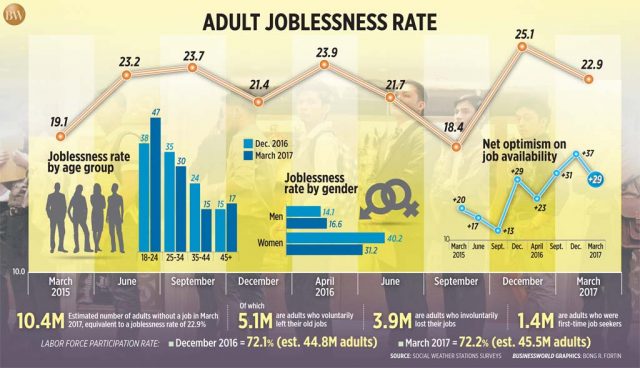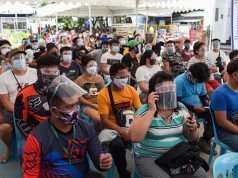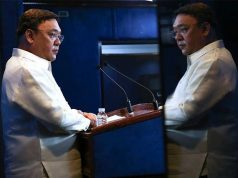MANILA – The Duterte Administration marked its first labor day commemoration with the jobless rate treading steady and a slightly lower – though still “high” – net optimism on job availability in the year ahead, according to results of the 2017 First Quarter Social Weather Stations (SWS) survey.
Conducted March 25-28 via face-to-face interviews with 1,200 adults nationwide and with a sampling error margin of ±3 points – the poll found adult joblessness at 22.9 percent or, extrapolated statistically, an estimated 10.4 million adults.
This is 2.2 points below the 25.1% (estimated 11.2 million adults) recorded in the December 2016 poll.
Read the report in Business World: Joblessness steadies, optimism slips.
The SWS’ definition of “joblessness” differs from the government’s “unemployment” concept; hence, the results of their surveys cannot be compared.
SWS defines joblessness based on two traditional qualifications: without a job at present and are looking for a job. Those not working, without a job but not looking for one — such as housewives and students – are excluded.
The SWS first-quarter joblessness rate consisted of:
- 11.2% or an estimated 5.1 million adults who voluntarily left their jobs compared to December’s 12.2% or an estimated 5.5 million adults;
- 8.6% or an estimated 3.9 million adults who lost their jobs due to economic circumstances beyond their control, similar to the 8.7% or an estimated 3.9 million adults in the fourth quarter of 2016; and
- 3.1% or an estimated 1.4 million adults who were first-time job seekers, down from the 4.3% or an estimated 1.9 million adults in October-December last year.
The March survey put adult labor force participation rate at 72.2% or 45.5 million adults, hardly changed from December’s 72.1% or an estimated 44.8 million adults.
The same survey also showed a lower net optimism on job prospects in the next 12 months that was nevertheless deemed “high”.
Optimism that there will be more jobs in the next 12 months fell to 44% in March from December’s 48%, those who believed there will be fewer jobs in the same period edged up to 15% from 12%, while those who said there will be no change in job availability hardly moved to 27% from December’s 28%.
This, in turn, yielded a “high” +29 net optimism on job availability in March that was nevertheless eight points and one grade down from the record-high “very high” +37 logged in December 2016.
The SWS classifies as “very high” a net optimism score of at least +30; +20 to +29 as “high”; +10 to +19, “fair”; +1 to +9, “mediocre”; -9 to zero, “low”; as well as -10 and below as “very low”.
Sought for comment, both government and labor group spokesmen attributed the marginal dip in joblessness to government efforts to ramped up public works.
For his part, Presidential Spokesperson Ernesto C. Abella said in a statement that the latest survey “affirms the significant strides of the Duterte administration in making the economy robust and sustainable and in laying down the foundation for inclusive growth.”
Alan A. Tanjusay, spokesman of the Associated Labor Unions-Trade Union Congress of the Philippines, said separately via mobile phone message that “this is because of the recent construction boom in the country… because many companies have opened up and took in employees in anticipation of (Mr.) Duterte’s plan to build, build, build.”
The Duterte administration is reforming the tax system in a bid to raise more funds – while shifting the burden more to those who can afford higher taxes – in order to ramp up spending on infrastructure and social services. The government believes increased spending, in turn, will spur GDP growth to an annual average of 7-8% in 2017-2022 from the 6.2% average in the six years under its predecessor. The administration believes such pace of economic expansion is needed to slash unemployment rate to 3-5% by 2022 from 5.5% last year and achieve its bottom line of cutting the national poverty rate to 14% also by then from 21.6% in 2015.










